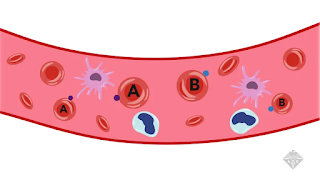Name of the experiment: ABO blood group determination
Principle
ABO blood group system is a method of classifying human blood on the basis of inherited properties of red blood cells (Erythrocytes). The blood groups A, B and 0 were first identified by the Austrian immunologist Karl Landsteiner in 1901.
Blood cells are covered with polysaccharides known as antigens which react with antibodies found in blood serum (Plasma) causing blood cells to coagulate in agglutination. Agglutination reactions cause clumping of red blood cells. There are two basic antigens A and B. There are antibodies to both of these antigens known as anti-A and anti-B. A person's red blood cells can have either or both or none of these antigens resulting in 4 different blood types (A, B, AB or O).
The purpose of the antibodies in the blood serum is to attack invaders that enter the blood system, e.g. viruses or bacteria. A type A person produces anti-B antibodies that destroys type B blood cells and vice versa. Type 0 people have both anti-A and anti-B antibodies in their serum but neither of the antigens. Type AB people have both of the antigens but neither of the antibodies. Using the wrong blood type can be fatal during blood transfusions and organ transplants.
There is another system of blood typing known as Rhesus or Rh system. People can either have the Rh antigen (Also known as D antigen), in which case they are Rh positive or not (Rh negative). About 85% of the population is Rh positive. Generally, 41% of the population are type A, 10% are type B, 4% are type AB and 45% are type 0. Type 0 people are universal donors, while type AB people are universal receivers.
Table: Overview of the ABO blood group system
Materials and Reagents
Ø Microscope slides
Ø Blood lancets
Ø Blood grouping test kits
Ø Blood samples
Methods
Divide a slide into three parts using a sign pen. Mark one part as A, the second part as B and the third part as D.
Wipe middle finger with alcohol saturated cotton and prick with a sterile needle.
Put three drops of blood on the three separate parts of the slide.
Put a drop of anti-A serum on part A, a drop of anti-Bon part Band anti-Don part D. Mix the serums and blood with sticks.
Observations and Results:
Here'+ ' means agglutination or clumping of cells and'-' means no reaction



